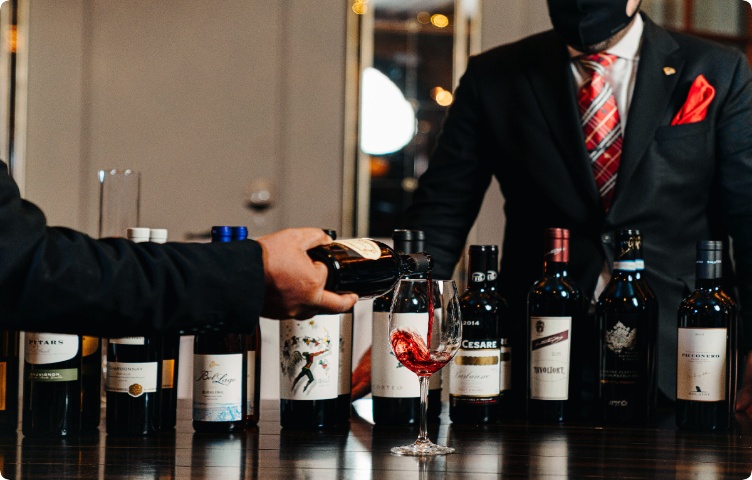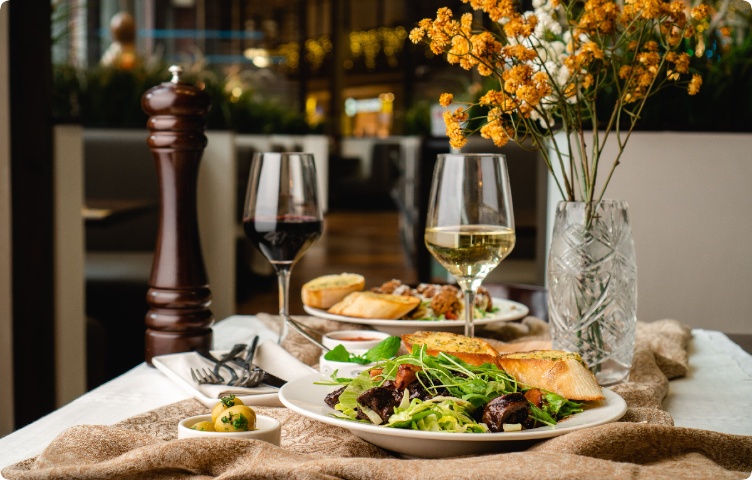One of the most enjoyable parts of dining at a restaurant is choosing the perfect wine pairing to pair with the dishes you order. But the sheer variety of options on the wine list can make anyone's head spin. Whether your visit to a restaurant is a rare treat or a regular occurrence, ordering wine can be as stressful as paying a large bill. This pain is especially true when the wine menu takes up several pages and does not contain useful descriptions.
In this article we will look at some useful tips from professional sommeliers on how to choose wine in a restaurant and enjoy the process.

Familiarize yourself with wine terms
The long list of wine terms could probably fill an entire dictionary, but there are a few collocations you should learn before flipping through a wine menu.
Tannins: compounds found in grape seeds, skins and stems. Tannins give the wine an “astringent and dry” taste.
Variety: The type of grape from which a particular wine is made.
Terroir: The influence of environmental factors such as soil and climate on the taste of wine.
Oaky: A popular term for a wine with woody notes.
Bouquet: The aroma of wine.
Dry: Dry wines contain little or no residual sugar and are generally not sweet.
Light: Wine containing less than 12.5% alcohol. Examples include Pinot Noir, Grenache and Barbera.
Full-bodied: Wine with an alcohol content of more than 13.5%. These wines go well with steak.
Finish: Aftertaste of wine.
Breathing the wine: The expression “letting the wine breathe” means aeration. As a result of interaction with oxygen, the wine “breathes” and “opens”.
Millesime (from the French le millésime): in winemaking and oenology, the year of ripening of the grape harvest from which the given wine or other alcoholic drink (cognac, Armagnac, etc.) is produced.
Best Wines for Beginners
If you are not too familiar with wine, it is better not to become attached to a specific grape variety. Order a Pinot Grigio or Pinot Gris if you want to try a white wine. Or Grenache if you want to try red.

Learn the basics of wine and food pairing
Stronger wines usually pair best with hearty meat dishes, while lighter wines pair well with fish and pasta. If you have steak on your plate , your glass should contain Petite Sirah or Cabernet Sauvignon. Pasta with red sauce calls for a bottle of Pinot Noir or Merlot, while fancy fish dishes are best paired with Chardonnay or Sauvignon Blanc.
Don't be afraid to experiment!
While you may have a clear preference for a certain type of wine, it's also worth being open to new experiences. Trying something unusual and exotic can sometimes be a pleasant surprise. Don't forget that restaurant wine lists often include unconventional regions and wines that are chosen for their quality and value.
Contact the sommelier
If you are unfamiliar with most of the names on the wine list, feel free to chat with the sommelier or other members of the restaurant team. Discussing wines with a sommelier can be the key to successful selections. You can tell us about your budget, wine and food preferences, and the sommelier will be happy to help you choose the right option. The more information you give, the easier it will be for him to help you make the right decision. At the same time, you will not look like an amateur looking for advice, but quite the opposite - a person who knows exactly what he wants. Start a conversation about wine. After all, the sommelier chose these particular wines for his list for a reason - let him tell you about the positions on the menu, and together you can make an informed choice that suits your tastes, budget and dishes on your table. Tell the sommelier what you and your companions like and dislike; for example, do you prefer reds that are fruity and light, or rich and spicy? Then discuss what would go best with your dish. If you're on a budget, ask your sommelier to find the most interesting wine for your money.

Choosing the right wine isn't just a walk in the park, but it's also not rocket science. Regardless of whether you are a beginner or an expert, it is always useful to have a guideline to help youmove in the right direction.
By following these tips, you can make the wine selection process more enjoyable and interesting. Feel free to talk to the experts and trust your taste - after all, you will ultimately be the one enjoying your glass of wine!
















































/https%3A%2F%2Fcomplexbar.com%2Fimages%2Fblog%2F244%2Fdzen_vino_glavn.jpg)
/https%3A%2F%2Fcomplexbar.com%2Fimages%2Fblog%2F246%2Fsirop_scale_2400.jpeg)
/https%3A%2F%2Fcomplexbar.com%2Fimages%2Fblog%2F246%2Fkofe-vostochniy.jpg)
/https%3A%2F%2Fcomplexbar.com%2Fimages%2Fblog%2F245%2Fpexels-jason-villanueva-851555.jpg)
/https%3A%2F%2Fcomplexbar.com%2Fimages%2Fblog%2F246%2F2024-04-09_17.22.54.jpg)
/https%3A%2F%2Fcomplexbar.com%2Fimages%2Fblog%2F246%2F2024-04-09_17.22.47.jpg)
/https%3A%2F%2Fcomplexbar.com%2Fimages%2Fblog%2F246%2FCODE_anons_foamydrops_752%D1%85480_eng.jpg)
/https%3A%2F%2Fcomplexbar.com%2Fimages%2Fblog%2F246%2FAlina_752%D1%85480_eng.jpg)
/https%3A%2F%2Fcomplexbar.com%2Fimages%2Fblog%2F246%2F2024-04-09_17.23.22.jpg)
/https%3A%2F%2Fcomplexbar.com%2Fimages%2Fblog%2F246%2F2024-04-09_17.23.28.jpg)
/https%3A%2F%2Fcomplexbar.com%2Fimages%2Fblog%2F246%2F2024-04-09_17.23.35.jpg)
/https%3A%2F%2Fcomplexbar.com%2Fimages%2Fblog%2F246%2Fdrinksome_752%D1%85480_eng.jpg)
/https%3A%2F%2Fcomplexbar.com%2Fimages%2Fblog%2F246%2Fnude_752%D1%85480_eng.jpg)
/https%3A%2F%2Fcomplexbar.com%2Fimages%2Fblog%2F246%2F752%D1%85480_eng__1_.jpg)
/https%3A%2F%2Fcomplexbar.com%2Fimages%2Fblog%2F246%2F752%D1%85480_eng.jpg)
/https%3A%2F%2Fcomplexbar.com%2Fimages%2Fblog%2F246%2FStudioRaw_752%D1%85480_eng.jpg)
/https%3A%2F%2Fcomplexbar.com%2Fimages%2Fblog%2F246%2FDoppio_tea_752%D1%85480_eng.jpg)
/https%3A%2F%2Fcomplexbar.com%2Fimages%2Fblog%2F246%2FTognana_Stars_Stripes_752%D1%85480_eng.jpg)
/https%3A%2F%2Fcomplexbar.com%2Fimages%2Fblog%2F246%2FRona_752%D1%85480_eng.jpg)
/https%3A%2F%2Fcomplexbar.com%2Fimages%2Fblog%2F246%2FDoppio_vending_752%D1%85480_eng.jpg)
/https%3A%2F%2Fcomplexbar.com%2Fimages%2Fblog%2F246%2FEssence_sukhie_smesi_752%D1%85480_eng.jpg)
/https%3A%2F%2Fcomplexbar.com%2Fimages%2Fblog%2F246%2FODK_sukhie_smesi752%D1%85480_eng.jpg)
/https%3A%2F%2Fcomplexbar.com%2Fimages%2Fblog%2F246%2Funiforma-barmena.jpg)
/https%3A%2F%2Fcomplexbar.com%2Fimages%2Fblog%2F246%2Fkak-nanyat-barmena.jpg)
/https%3A%2F%2Fcomplexbar.com%2Fimages%2Fblog%2F246%2Fsirop_scale_2400.jpeg)
/https%3A%2F%2Fcomplexbar.com%2Fimages%2Fblog%2F246%2FPeugeot_Anons_Paris_U%27Select_Line_Daman_752%D1%85480_eng.jpg)
/https%3A%2F%2Fcomplexbar.com%2Fimages%2Fblog%2F246%2Fkofe-vostochniy.jpg)
/https%3A%2F%2Fcomplexbar.com%2Fimages%2Fblog%2F246%2FMadler.jpg)
/https%3A%2F%2Fcomplexbar.com%2Fimages%2Fblog%2F246%2Fprofbartender_glavn.jpeg)